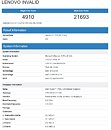Tuesday, January 21st 2020

AMD "Renoir" Ryzen 7 4700U Geekbenched
An unknown Lenovo notebook powered by the 15-Watt Ryzen 7 4700U "Renoir" 8-core processor was put through Geekbench. The chip yielded scores of 4910 single-core, and 21693 multi-core. This puts the 4700U ahead of the Core i7-1065G7, which is known to score around 4400 points on average in the single-core test, and around 17000 on average, in the multi-core test, falling behind due to fewer CPU cores. The 4700U features an 8-core CPU based on the "Zen 2" microarchitecture. Its desktop compatriot, the Ryzen 7 3700X, is significantly faster, with around 20% higher single-core, and over 60% higher multi-core performance. This is probably because the 3700X is unconstrained with its 65-Watt TDP and significantly higher power limits. It also has four times more L3 cache, but that's probably to cushion the IFOP interconnect between the CPU chiplet and I/O die.
Sources:
tamz_msc (Reddit), Geekbench Database



49 Comments on AMD "Renoir" Ryzen 7 4700U Geekbenched
Can't wait for the reviews and especially the desktop versions of Renoir to come out.
Renoir should fix the problem with Ryzen 3000 high idle power consumption floor (about 10W) and being monolithic should have memory controller with lower latency.
Looking forward to some proper reviews. My only real concern is battery life and if the notebook makers will finally put proper dual-channel memory support in their machines for AMD.
Also, I don't understand why both AMD and fans keep comparing to Ice Lake, when a more potent Comet Lake CPUs are available.
Also hope AMD will release Ryzen 9 4900H , unlocked with 3.5Ghz base, 4.5Ghz boost @ 54W TDP just to make lol against Intels 10980HK ;-).
this "4900H" + 4266Mhz mem could make really great "Laptop" ;-).
I don't think going 4266Mhz mem is a great idea considering the Infinity Fabric and its divider when mem frequency goes more than 3600Mhz?(was it 3600Mhz or more?) going more than that will actually make it slower.
.dram_speed_mts = 1600.0 => .fabricclk_mhz = 600.0 // DRAM @ 1600 MHz = IF @ 600 MHz
^-- probably a weird idle.
.dram_speed_mts = 2133.0 => .fabricclk_mhz = 1066.0 // DRAM @ 2133 MHz = IF @ 1066 MHz
.dram_speed_mts = 4266.0 => .fabricclk_mhz = 1600.0 // DRAM @ 4266 MHz = IF @ 1600 MHz
^-- If it was 3200 MHz, fabric clock would probably be also 1600 MHz.
From AnandTech's launch article (there's a link here, experience tells me I have to make that explicit for you):So what you're saying is true for desktop Zen2, but not mobile Zen2 (Renoir).
High speed IF can use quite a lot of power, so I would guess the mobile implementation is designed to hit a perf/w sweet spot but also possibly clock down when not needed. Unlinking this from memory clock speeds thus makes a lot of sense.
In terms of CPU performance, 15W ultraportable customers really aren't clamouring for more cores. Those products are typically not multitasking mobile workstation powerhouses, lacking RAM, screen size, and storage for many serious workloads. To date, the vast majority of 3700U flagship APUs have been either 8GB or 16GB max, with 512GB NVMe 2x and 1080p displays. They are general-purpose consumption devices that could definitely use a little more GPU power but are typically beyond the point of diminishing returns in the CPU department already.
AMD keep saying that they have added 60% more performance per CU but then have stripped away 30-40% of the CUs The fact that AMD isn't singing praises about the 3D performance of its new 7nm APUs is a pretty bad sign of things to come, especially because the 4800U is likely to command a significant price premium. I would expect the 6CU option to sell at the same pricing tier as the previous 10CU 3700U models, which sucks because the 4800U will likely be price-competing against an MX250 or even faster dGPU options. I can only hope that LPDDR4X is used to its full advantage this generation. My 2700U shipped with a 13W TDP and single-channel DDR4 2400; The only reason I bought it was good cooling (for up to 25W) and an empty DIMM slot for dual-channel.
Is it too much to ask for a 15W ultraportable that provides a meaningful IGP upgrade? The bar is SO low, I'm honestly saddened by the lack of attempts to pass it.